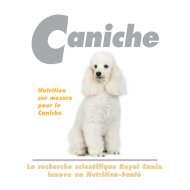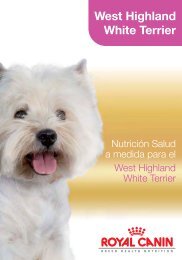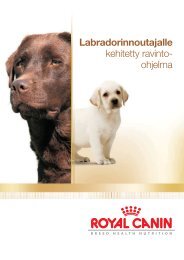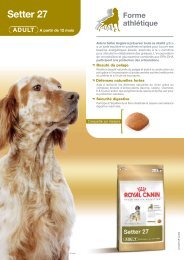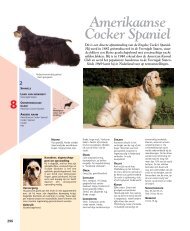Specific breed brochure - Breed Nutrition
Specific breed brochure - Breed Nutrition
Specific breed brochure - Breed Nutrition
Create successful ePaper yourself
Turn your PDF publications into a flip-book with our unique Google optimized e-Paper software.
Objective #2: facilitating<br />
the use of fatty acids<br />
through L-carnitine<br />
L-carnitine is the only substance that can<br />
transport long-chain fatty acids to the<br />
mitochondria*, where they are oxidised<br />
to produce energy. L-carnitine is synthesised<br />
in the liver but the more active the<br />
dog, the greater the risk that this process<br />
will be restricted.<br />
When the content is increased in the food<br />
(700 IU/kg in Rottweiler 26), the<br />
serum L-carnitine concentration will<br />
return to normal much faster. L-carnitine<br />
is traditionally used in slimming diets to<br />
accelerate weight loss while preserving<br />
lean mass (Allen, 1998).<br />
Objective #3: providing sufficient calories<br />
to cover expended energy<br />
A high fat diet (20% in Rottweiler 26) helps spare the glycogen* reserves in the muscles as their<br />
exhaustion corresponds to the appearance of signs of fatigue in dogs (Grandjean, 1983).<br />
A diet rich in fats improves a dog’s sporting performance in endurance (Reynolds, 1998) and<br />
speed disciplines (Hill et al, 2000). It increases the maximum amount of oxygen – VO2 max* –<br />
that the body is able to use (Reynolds and Taylor, 1996).<br />
It is important to maintain a good balance between omega 6 and omega 3 unsaturated fatty acids<br />
through an intelligent mix of fat sources (animal fat, fish oil, soy oil and copra). Copra provides<br />
short-chain fatty acids, which are not well incorporated into fat tissue and do not require the presence<br />
of L-carnitine to provide energy to the muscle cells.<br />
% mitochondrial<br />
volume/muscle fibre<br />
20<br />
15<br />
10<br />
5<br />
0<br />
Impact of fat content in the diet<br />
on the capacity of the muscle cells<br />
to produce energy from fatty acids<br />
Study on dogs trained for three months and fed with each of the diets<br />
before measurement (Reynolds & Taylor, 1996)<br />
19<br />
11,59<br />
+ 37 %<br />
15,97<br />
High carbohydrate diet* High lipid diet**<br />
* Carbohydrates<br />
represent 65%<br />
of metabolisable<br />
energy<br />
**Lipids represent<br />
65% of<br />
metabolisable<br />
energy<br />
The mitochondrial volume is a manifestation of the cell’s ability to oxidise fatty acids to<br />
produce energy. A high fat diet improves the body’s ability to burn fat. When a<br />
carbohydrate-rich diet is imposed there is a return to initial values.



